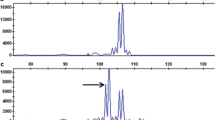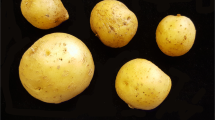Summary
The genetic basis of the resistance to a pepper strain of potato virus Y (PVY pathotype 1–2) was investigated in two lines: Capsicum annuum ‘Criollo de Morellos 334’ and Capsicum chinense ‘PI 159236’. F1, backcrosses, and F2 populations were produced using C. annuum ‘Magda’ as the susceptible parent. Segregation ratios indicated that the resistance in C. annuum ‘Criollo de Morellos 334’ is governed by a nuclear, single dominant gene with a very high but incomplete penetrance. On the other hand, the resistant response of C. chinense ‘PI 159236’ is associated with the presence of a major recessive gene with an apparently complete penetrance. The failure in recovering or detecting PVY from/in the inoculated leaves of both resistant genotypes is strongly suggestive that both genes are acting by preventing the multiplication of the virus in the leaf tissue. Both mechanisms of resistance closely resemble either an operational immunity or a single-cell hypersensitive reaction to PVY pathotype 1–2. The name Ry 1–2 is suggested for the resistance gene from ‘Criollo de Morellos 334’. The gene for resistance to PVY pathotype 1–2 identified in C. chinense ‘PI 159236’ may be the same designated et c1, which is mentioned to be allelic to the et av locus. The phenotypic expression of the et av gene was characterized in C. annuum ‘Avelar’ as a tolerant but not immune or hypersensitive reaction against some potyviruses in Florida. These data suggest that a critical reexamination of the allelic relationships at the locus et should be performed.
Similar content being viewed by others
References
Black L.L., H.A.Hobbs & J.M.GattiJr., 1991. Tomato spotted wilt virus resistance in Capsicum chinense PI 152225 and PI 159236. Plant Dis. 75: 863.
Boiteux L.S., 1995. Allelic relationships between genes for resistance to tomato spotted wilt tospovirus in Capsicum chinense. Theor. Appl. Genet. 90: 146–149.
Boiteux L.S. & A.C.deAvila, 1994. Inheritance of a resistance specific to tomato spotted wilt tospovirus in Capsicum chinense ‘RI 159236’. Euphytica 75: 139–142.
Boiteux L.S. & L. de B.Giordano, 1993. Genetic basis of resistance against two Tospovirus species in tomato (Lycopersicon esculentum). Euphytica 71: 151–154.
Boiteux L.S. & T.Nagata, 1993. Susceptibility of Capsicum chinense ‘PI 159236’ to tomato spotted wilt virus isolates in Brazil. Plant Dis. 77: 210.
Boiteux L.S. & H.B.S.V.Pessoa, 1994. Additional sources of resistance to an isolate of PVYm in Capsicum germplasm. Fitopatol. Bras. 19: 402.
Boiteux L.S., F.P.Cupertino & F.J.B.Reifschneider, 1993a. Capsicum chinense PI 159236: A source of resistance to tomato spotted wilt virus and Phytophthora capsici. Capsicum & Eggplant Newsletter 12: 76.
Boiteux L.S., T.Nagata, W.P.Dutra & M.E.N.Fonseca, 1993b. Sources of resistance to tomato spotted wilt virus (TSWV) in cultivated and wild species of Capsicum. Euphytica 67: 89–94.
Boukema I.W., 1980. Allelism of genes controlling resistance to TMV in Capsicum L. Euphytica 29: 433–439.
Committee for Capsicum Gene Nomenclature, 1994. Rules for gene nomenclature of Capsicum. Capsicum & Eggplant Newsletter 13: 13–14.
Cupertino F.P., F.J.B.Reifschneider & M.F.Batista, 1988. Avaliação da reação de Capsicum aos virus Y da batata e vira-cabeça do tomateiro. Fitopatol. Bras. 13: 148.
Cupertino F.P., P.B.Sa, R.B.Medeiros & C.G.P.Carvalho, 1991. Purificação e sorologia de uma estirpe de PVY causadora de mosaico em pimentao (Capsicum annuum) ‘Magda’. Fitopatol. Bras. 16: 28.
Fraser R.S.S., 1990. The genetics of resistance to plant viruses. Annu. Rev. Phytopathol. 28: 179–200.
Gebre-Selassie K., G.Marchoux, B.Delecolle & E.Pochard, 1985. Variabilite naturelle des souches du virus Y de la pomme de terre dans les cultures de piment du sud-est de la France. Agronomie 5: 621–630.
Green, S.K. & J.S. Kim, 1991. Characteristics and control of viruses infecting peppers: A literature review. Asian Vegetable Research and Development Center (AVRDC). Technical Bulletin No. 18.
Greenleaf W.H., 1986. Pepper breeding. In: M.J.Bassett (Ed). Breeding Vegetable Crops. AVI Publishing Company, Westport, Connecticut.
Johnson R., 1984. A critical analysis of durable resistance. Annu. Rev. Phytopathol. 22: 309–330.
Miranda J.E.C., C.D.Cruz & C.P.Costa, 1988. Prediction of sweet pepper (Capsicum annuum L.) hybrid behavior based on parental genetic divergence. Rev. Brasil. Gen. 11: 929–937.
Nagai H., 1983. Melhoramento de pimentão (Capsicum annuum) visando resistencia ao virus Y. Hort. Bras. 1: 3–9.
Pochard E., K.Gebre-Selassie & G.Marchoux, 1983. Oligogenic resistance to potato virus Y pathotype 1–2 in the line ‘Perennial’. Capsicum Newsletter 2: 137–138.
Ponz F. & G.Bruening, 1986. Mechanisms of resistance to plant viruses. Annu. Rev. Phytopathol. 24: 355–381.
Provvidenti R. & R.O.Hampton, 1992. Sources of resistance to viruses in the Potyviridae. Arch. Virol. (supplementum) 5: 189–211.
Reifschneider F.J.B., L.S.Boiteux, P.T.Della Vecchia, J.M.Poulos & N.Kuroda, 1992a. Inheritance of adult-plant resistance to Phytophthora capsici in pepper. Euphytica 62: 45–49.
Reifschneider F.J.B., L.S.Boiteux & T.Nagata, 1992b. Fonte de resistencia genetica multipla a Phytophthora capsici, tomato spotted wilt virus (TSWV) e potato virus Y (PVY) em Capsicum. Fitopatol. Bras. 17: 209.
Shifriss C. & S.Marco, 1980. Partial dominance of resistance to potato virus Y in Capsicum. Plant Dis. 64: 57–59.
Shukla D.R., C.W.Ward & A.A.Brunt, 1994. The Potyviridae. CAB International, Wallingford, U.K.
Subramanya R., 1982. Relationship between tolerance and resistance to pepper mottle virus in a cross between Capsicum annuum L. x Capsicum chinense Jacq. Euphytica 31: 461–464.
White R.F. & J.F.Antoniw, 1991. Virus-induced resistance response in plants. Critical Rev. Plant Sci. 9: 443–455.
Zitter T.A. & A.A.Cook, 1973. Inheritance of tolerance to a pepper virus in Florida. Phytopathology 63: 1211–1212.
Author information
Authors and Affiliations
Rights and permissions
About this article
Cite this article
Boiteux, L.S., Cupertino, F.P., Silva, C. et al. Resistance to potato virus Y (pathotype 1–2) in Capsicum annuum and Capsicum chinense is controlled by two independent major genes. Euphytica 87, 53–58 (1996). https://doi.org/10.1007/BF00022964
Received:
Accepted:
Issue Date:
DOI: https://doi.org/10.1007/BF00022964




